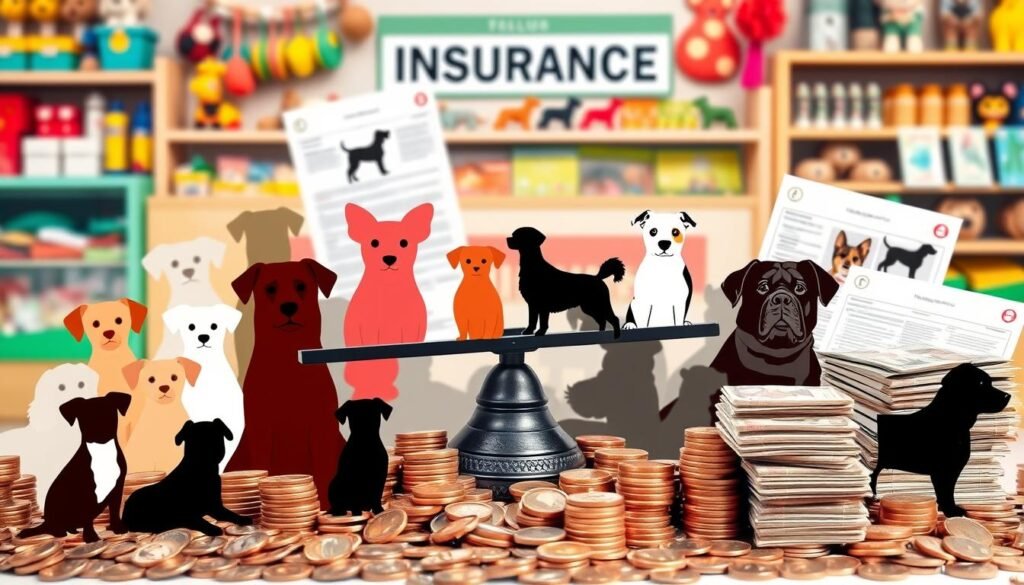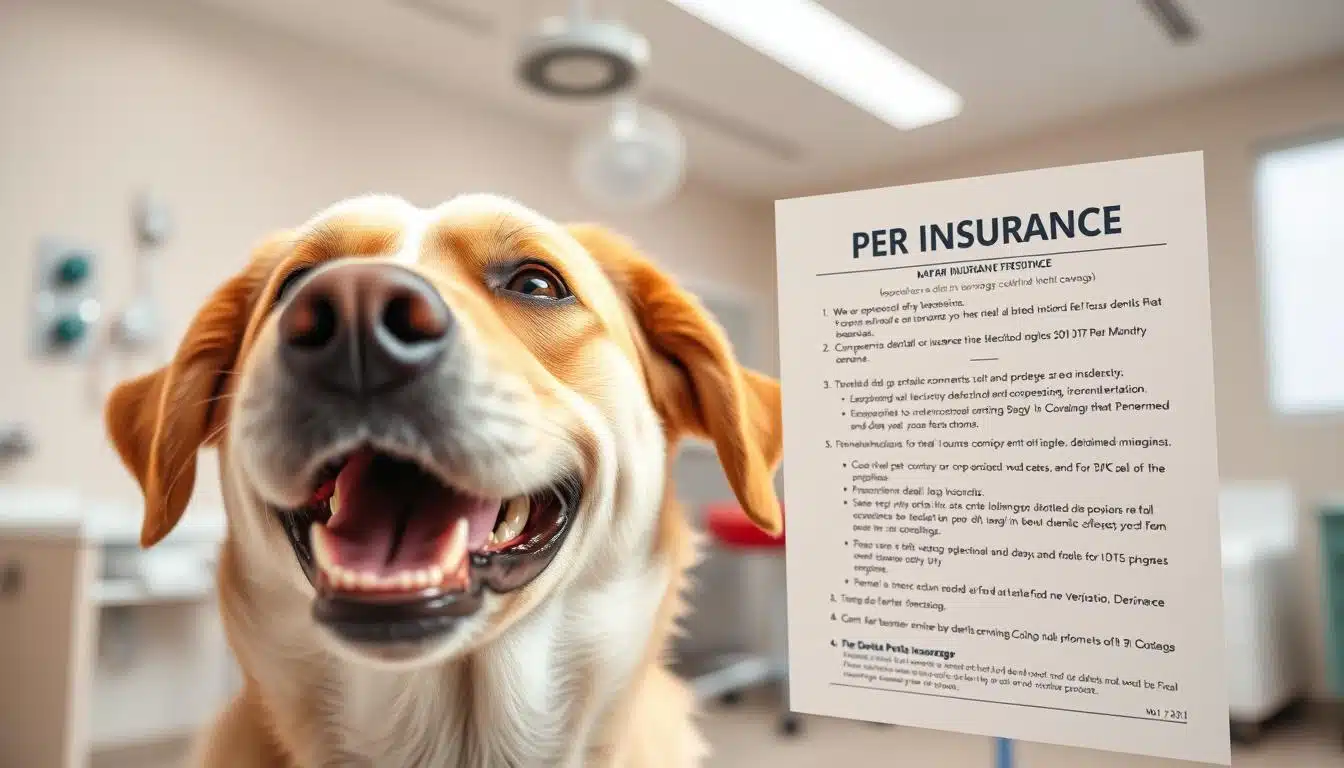If you are a dog owner, it is important to know about dog’s breed which affects your insurance cost . Some breeds are seen as higher risk by insurers. This can make your liability coverage costs go up a lot.
In 2023, dog bites cost insurers $1.1 billion. Almost 800,000 people get hurt by dogs every year. It’s important to understand how your dog might change your insurance policy. In these details, I’ll cover every step about how much more will a dog breed increase insurance.
Table of Contents
ToggleKey Takeaways:
- Certain dog breeds are considered higher risk by insurance providers, leading to increased liability coverage costs.
- Dog bite and related injury claims cost insurers $1.1 billion in 2023, with nearly 800,000 Americans needing medical attention annually due to dog bites.
- Understanding the impact of your dog’s breed on your homeowners insurance premiums is crucial for pet owners.
- Insurers may choose to increase premiums for high-risk dog breeds to mitigate financial liability in dog-related incidents.
- Responsible pet ownership and bite prevention measures can help pet owners navigate the complexities of dog breed and insurance coverage.
Introduction: Understanding the Impact of Dog Breeds on Insurance Costs
As a pet owner, I know how much joy and companionship our canine friends bring. But, owning a dog comes with responsibilities and risks. These can affect our homeowners insurance policies. The breed of your dog is key for insurers when setting coverage and premiums.
Dog bites and attacks can lead to big medical bills, property damage, and legal trouble. Insurers know this and adjust policies based on breed. Breeds like Rottweilers, Pit Bulls, and German Shepherds are often seen as more aggressive. They might not be covered by many insurers.
Knowing how dog breeds affect insurance costs is crucial for pet owners. By understanding what insurers look for, owners can lower risks. This can lead to better policy terms. It helps you make smart choices about your pet, coverage, and the costs of dog ownership.
| Dog Breed | Estimated Increase in Insurance Premiums |
|---|---|
| Rottweiler | 20-30% |
| Pit Bull | 25-35% |
| German Shepherd | 15-25% |
| Chow Chow | 20-30% |
| Wolf Hybrid | 30-40% |
The table shows how much more certain dog breeds can increase insurance costs. Remember, these numbers can change based on where you live, your insurance, and other factors.
Understanding the impact of dog breeds on insurance costs helps pet owners make better choices. This knowledge ensures you and your dog are protected. It also helps lower the financial costs of dog ownership.
Dog Breed Restrictions and Insurance Policies
Homeowners insurance often has rules for certain dog breeds. Insurers look at media, past claims, and breed behaviors. They do this to avoid expensive claims from dog incidents.
Common Breeds on Restricted Lists
Insurance companies often don’t cover dogs like Akita, Alaskan Malamute, and Chow Chow. Also, Doberman Pinscher, German Shepherd, and Husky are on the list. Mastiff, Pit Bull, Presa Canario, Rottweiler, and Wolf Hybrid are too. These dogs are seen as more aggressive or likely to bite.
Why Insurers Consider Breed When Underwriting
Insurers focus on dog breeds to lower risk and avoid big claims. They look at media, past claims, and bite reports. This helps them decide which dogs to restrict.
“The average cost per dog bite claim in 2023 was almost $60,000, according to Triple-I data. This high financial burden is a key reason why insurers carefully evaluate dog breeds when underwriting policies.”
Despite debates, insurers keep breed restrictions to manage risk and control homeowners insurance premiums. This can be tough for pet owners. It shows the need for a fair approach that balances safety and responsible pet care.
How Insurers Assess Aggressive Dog Breeds
As a pet owner, knowing how insurance companies view dog breeds is key. They look at claim history to figure out the risks. This can mean higher costs or even no coverage for some breeds.
Dogs like Pit Bull Terriers, Rottweilers, and German Shepherds are often seen as risky. Their strength and powerful jaws can cause serious injuries. But, any dog can be aggressive if not trained right.
On the other hand, breeds like Labradors and Golden Retrievers might get better insurance deals. Insurers look at each dog’s history and behavior, not just its breed.
“Dog bites account for one-third of all homeowners insurance claims, with an average payout of $58,545 in 2023.”
Insurance companies use data on dog bites to set their policies. Some breeds are more likely to bite, leading to more claims. This makes insurers wary of certain breeds.
The debate on how insurance views dog breeds is complex. While breed is a factor, insurers also look at each dog’s behavior and how well it’s cared for.
The Role of Breed-Specific Legislation (BSL)
BSL laws aim to control dog breeds seen as dangerous. Yet, many argue these laws are based on wrong information. They say BSL doesn’t really keep people safe. Insurance groups, however, support these laws and fight against changes.
Debate Around BSL’s Effectiveness
Whether you’re affected by BSL laws depends on where you live. Some places have rules or bans on certain breeds. The argument over BSL’s worth keeps going. Some say it helps manage risks, while others claim it unfairly targets specific breeds.
- More than 700 U.S. cities have enacted breed-specific laws, typically regulating breeds like pit bulls, Rottweilers, and Doberman Pinschers.
- Studies show that breed-specific laws do not make communities safer for people or companion animals.
- The Centers for Disease Control and Prevention (CDC) strongly opposes BSL after studying human fatalities from dog bites.
- Breed-specific laws can lead to negative consequences like restricted outdoor exercise, limited veterinary care, and difficulties for residents to adopt regulated breeds.
- Responsible owners of regulated breeds may face housing issues, legal fees, or relinquishment of their animals due to breed bans and regulations.
- Breed-neutral alternatives, such as enhanced enforcement of dog license laws and laws promoting responsible dog ownership, may be more effective.
The debate on BSL’s effectiveness is ongoing. Both sides have strong points. As a pet owner, knowing your local laws is key. It helps with responsible pet care and avoids legal trouble.
Statistics on Dog Bites and Liability Claims
In 2023, dog bite claims went up to 19,062 from 17,597 in 2022. This is an 8.3% increase, says the Insurance Information Institute (Triple-I). These claims cost insurers $1.1 billion in 2023. Almost 800,000 people see a doctor each year after dog bites.
More than 17,000 insurance claims are filed for dog bites yearly. The average cost of these claims is nearly $50,000.
The cost of dog bite claims went up by 28% in 2022 to $1.13 billion. The average cost per claim rose by 32% to $64,555. But, the number of dog-related injury claims dropped to 17,597 in 2022.
Despite this, dog bites still made up more than one-third of all homeowners’ liability claim dollars in 2021.
Dog bite claims have gone up by 44% in the last decade. They have increased by 172% since 2003. The average cost per claim has risen by 156% due to higher medical costs and bigger settlements.
Insurers may not insure people who own certain dog breeds. Some states have laws that make dog owners liable for injuries caused by their pets.
| Metric | 2023 | 2022 | 2021 |
|---|---|---|---|
| Number of Dog Bite Claims | 19,062 | 17,597 | 17,989 |
| Total Cost of Claims | $1.1 billion | $1.13 billion | $882 million |
| Average Cost per Claim | $58,545 | $64,555 | N/A |
The data shows how dog bites affect homeowners insurance claims. It’s a big challenge for insurers and policymakers. As more people own pets, it’s important to teach responsible dog ownership and manage risks well.
how much more will a dog breed increase insurance
Factors Affecting Premium Increases
If your dog’s breed is not covered by your insurance, or if it costs more, several things can affect the price. Insurers look at the breed’s history of biting and the injuries it has caused. They also check your dog’s behavior and how big and strong it is.
Your location can also play a role. Where you live and how common certain breeds are there can change the price.
Pit bulls are responsible for about 32% of fatal dog bites, making them the most dangerous. Rottweilers are the second most dangerous, followed by breeds like Akita and Boxer.
In a study of 10 popular dog breeds, the average monthly premium was $54. Rottweilers were the most expensive, with premiums 45% higher than average. Yorkshire Terriers were the cheapest, with premiums 41% lower than average.
| Dog Breed | Monthly Premium | Difference from Average |
|---|---|---|
| Rottweiler | $78.30 | 45% higher |
| French Bulldog | $66.18 | 22% higher |
| Bulldog | $62.76 | 16% higher |
| German Shepherd | $59.40 | 10% higher |
| Labrador Retriever | $54.00 | Average |
| Golden Retriever | $51.30 | 5% lower |
| Beagle | $46.98 | 13% lower |
| Poodle | $44.58 | 17% lower |
| Boxer | $43.92 | 19% lower |
| Yorkshire Terrier | $31.86 | 41% lower |
Not all big dogs cost more to insure. To lower your pet insurance costs, try getting quotes from different insurers. Consider an accident-only plan or raising your deductible. You can also lower the benefit limit or adjust the reimbursement rate.
Look for discounts, pay annually, and enroll your pet early. These can help lower your costs.
Alternatives for Owners of High-Risk Dog Breeds
Finding homeowners insurance for high-risk dog breeds can be tough. But, there are ways to lessen the cost and find better coverage.
Finding Breed-Friendly Insurers
If your current insurer won’t cover your dog, look for others that might. Companies like State Farm, Chubb, and USAA might be more open. They might have looser breed rules or special pet plans.
Pet Liability Insurance Options
Consider pet liability insurance. It covers damage or injury from any dog. This can help you get homeowners insurance easier.
Also, training your dog for the Canine Good Citizen certification can help. Some insurers might cover restricted breeds if they show good behavior.
Working with insurance brokers can also help. They know which companies are more open to covering high-risk breeds. This can lead to the right coverage for you.
| Insurer | Breed-Friendly Policies |
|---|---|
| State Farm | Offers coverage for many high-risk breeds, including Pit Bulls, Rottweilers, and German Shepherds, with a focus on responsible pet ownership. |
| Chubb | Provides specialized pet liability coverage, which can help pet owners with high-risk breeds obtain homeowners insurance. |
| USAA | Considers each dog on a case-by-case basis, rather than applying blanket breed restrictions, making them a more accommodating option for high-risk breeds. |
“Responsible pet ownership, including proper training and socialization, can play a crucial role in mitigating the risk associated with high-risk dog breeds and obtaining favorable insurance coverage.”
Responsible Pet Ownership and Bite Prevention
As a dog owner, preventing your dog from biting is key to avoiding insurance claims. The ASPCA and AVMA have tips to help. These tips can reduce the risk of dog bites and protect your insurance.
Choosing the right dog and learning about its breed is crucial. Knowing your dog’s temperament helps keep everyone safe. Teaching kids and adults to understand dog body language is also important.
Socializing and training your dog early is vital. Expose them to people, animals, and places in a safe way. If your dog shows aggression, get help from a vet or trainer.
Keeping your dog healthy and up-to-date on shots is important. Taking care of your dog’s needs reduces the chance of a bite claim.
Remember, responsible pet ownership and proactive training and socialization are crucial to preventing dog bites and minimizing the impact on your insurance coverage. By following these guidelines, you can enjoy your dog’s company while avoiding risks.
“Among children, the rate of dog bite injuries is highest for those 5 to 9-years-old.”
It’s important to teach kids and adults how to safely interact with dogs. This education promotes safety and prevents bites. By being responsible pet owners, we can reduce dog bite claims and ensure a safe relationship between humans and dogs.
| Statistic | Value |
|---|---|
| Liability claims related to dog bites and other dog-related injuries | $1.12 billion in 2023 |
| Dog bite claims nationwide | Increased from 17,597 in 2022 to 19,062 in 2023 |
| Homeowners who did not understand homeowners liability coverage | 48% |
| Homeowners who did not know the amount of liability coverage they carried | 24% |
| Homeowners who made no effort to compare rates before acquiring homeowners insurance | One-third |
The table shows the need to educate pet owners and insurance buyers about dog ownership risks. Awareness and understanding lead to a safer environment for dogs and people.
Conclusion
Dog breeds can really affect how much homeowners insurance costs. Insurers watch certain breeds because they might bite more often. Breeds like Pit Bulls, Rottweilers, and Doberman Pinschers are seen as high-risk.
These dogs are bigger and stronger, which means they can cause more damage. This can lead to higher premiums or even no coverage at all.
Pet owners should train and socialize their dogs well. They should also know how their dog acts. Looking into pet liability coverage can help too.
FAQ
How can a dog breed impact homeowners insurance costs and coverage?
What are the most commonly restricted dog breeds for homeowners insurance?
Why do insurers consider certain dog breeds to be high-risk?
What is breed-specific legislation (BSL) and how does it impact insurance coverage?
How have dog bite claims and related costs impacted the insurance industry?
FAQ
How can a dog breed impact homeowners insurance costs and coverage?
Insurers watch certain dog breeds closely. They see them as high-risk because of dog bite incidents and injuries. This can lead to higher premiums or even no coverage for these breeds.
What are the most commonly restricted dog breeds for homeowners insurance?
The most restricted breeds include Akita, Alaskan malamute, and Chow Chow. Also, Doberman pinscher, German shepherd, and Husky are on the list. Mastiff, Pit bull, Presa Canario, Rottweiler, and Wolf Hybrid are too.
Why do insurers consider certain dog breeds to be high-risk?
Insurers look at dog attack statistics and injury severity. While any dog can be aggressive, some breeds are seen as more dangerous. This is because of their strength and jaws, leading to more severe injuries.
What is breed-specific legislation (BSL) and how does it impact insurance coverage?
BSL laws regulate or ban certain dog breeds. Whether you’re affected by BSL depends on where you live. Some states have restrictions or bans. The debate on BSL’s effectiveness is ongoing.
How have dog bite claims and related costs impacted the insurance industry?
In 2023, dog bite claims rose to 19,062 from 17,597 in 2022. This is an 8.3% increase. Liability claims for dog bites cost insurers $1.1 billion in 2023. Over 800,000 Americans see a doctor after dog bites each year. More than 17,000 insurance claims are filed for dog bites, with an average cost of nearly $50,000.
What factors can influence the cost increase for homeowners insurance due to a high-risk dog breed?
Insurers look at the breed’s biting history and injury severity. They also consider your dog’s behavior. The size and strength of the dog matter too. Your location and the commonality of certain breeds in your area can also affect premiums.
What are some options for owners of high-risk dog breeds to manage their insurance coverage?
Options include finding insurance providers that accept high-risk breeds. You can also get pet liability insurance. Getting Canine Good Citizen certification from the AKC may help. Working with insurance brokers can also help find companies with more lenient breed restrictions.
How can pet owners help prevent dog bites and minimize the impact on their insurance coverage?
Responsible pet ownership is key. This includes choosing the right dog and teaching it well. It’s important to understand a dog’s body language. Keeping your dog healthy and vaccinated helps too. If your dog shows aggression, seek help from a vet or dog trainer.
.1 billion in 2023. Over 800,000 Americans see a doctor after dog bites each year. More than 17,000 insurance claims are filed for dog bites, with an average cost of nearly ,000.
What factors can influence the cost increase for homeowners insurance due to a high-risk dog breed?
Insurers look at the breed’s biting history and injury severity. They also consider your dog’s behavior. The size and strength of the dog matter too. Your location and the commonality of certain breeds in your area can also affect premiums.
What are some options for owners of high-risk dog breeds to manage their insurance coverage?
Options include finding insurance providers that accept high-risk breeds. You can also get pet liability insurance. Getting Canine Good Citizen certification from the AKC may help. Working with insurance brokers can also help find companies with more lenient breed restrictions.
How can pet owners help prevent dog bites and minimize the impact on their insurance coverage?
Responsible pet ownership is key. This includes choosing the right dog and teaching it well. It’s important to understand a dog’s body language. Keeping your dog healthy and vaccinated helps too. If your dog shows aggression, seek help from a vet or dog trainer.












